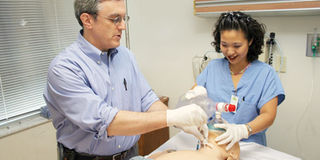Bringing the dead to life

Dr Samuel Tisherman, a resuscitation researcher and professor illustrates a technique of reviving someone who has gone into shock. He has been at the forefront of research meant to increase chances of people who suffer fatal injuries otherwise known as therapeutic hyperthermia.
NET PHOTOS
A radical procedure that involves replacing a patient’s blood with cold salt water could retrieve people from the brink of death, if a procedure doctors have tried out on animals comes to fruition.
“When you are at 10C, with no brain activity, no heartbeat, no blood – everyone would agree that you’re dead,” says Dr Peter Rhee at the University of Arizona, Tucson. “But we can still bring you back.”
Rhee isn’t exaggerating. With Dr Samuel Tisherman, at the University of Maryland, College Park, he has shown that it’s possible to keep bodies in ‘suspended animation’ for hours at a time. The procedure, so far tested on animals, is about as radical as any medical procedure comes: it involves draining the body of its blood and cooling it more than 20C below normal body temperature.
Once the injury is fixed, blood is pumped once again through the veins, and the body is slowly warmed back up. “As the blood is pumped in, the body turns pink right away,” says Rhee. At a certain temperature, the heart flickers into life of its own accord. “It’s quite curious, at 30C the heart will beat once, as if out of nowhere, then again – then as it gets even warmer it picks up all by itself.” Astonishingly, the animals in their experiments show very few ill-effects once they’ve woken up. “They’d be groggy for a little bit but back to normal the day after,” says Tisherman.
Tisherman created headlines around the world earlier this year, when he announced that they were ready to begin human trials of the technique on gunshot victims in Pittsburgh, Pennsylvania. The first patients will have been so badly wounded that their hearts have stopped beating, meaning that this is their last hope. “Cheating death with ‘suspended animation’” is how CNN put it; “Killing a patient to save his life” was the New York Times’ take.
WHEN ARE YOU DECLARED DEAD?
The news coverage has sometimes offended Tisherman’s cautious sensibility. During our conversation, he comes across as a thoughtful, measured man, who is careful not to oversell his research. He is particularly wary of using the term “suspended animation”. “My concern isn’t that it’s inaccurate – it’s that when people think of the term, they think about space travellers being frozen and woken up on Jupiter, or Han Solo in Star Wars,” he says. “That doesn’t help, because it’s important for the public to know it’s not science fiction – it’s based on experimental work and is being studied in a disciplined manner, before we use it to stop people dying.” Rhee, who came to global attention after treating congresswoman Gabrielle Giffords after a shooting in 2011, tends to be bolder: he says he wouldn’t rule out longer-term suspended animation, in the distant future. “What we’re doing is beginning part of that experiment.”
Tisherman’s quest to bring people back from the brink of death began at medical school, where he studied under Peter Safar. It is an inspiring dynasty: in the 1960s Safar had pioneered cardiopulmonary resuscitation (CPR), the now familiar procedure of applying pressure to the chest cavity to try to massage the heart back to life.
Safar’s work began to change our perceptions of death – blurring the point that is meant to mark the end of our lives. “We’ve all been brought up to think death is an absolute moment – when you die you can’t come back,” says Dr Sam Parnia, at the State University of New York in Stony Brook. “It used to be correct, but now with the basic discovery of CPR we’ve come to understand that the cells inside your body don’t become irreversibly ‘dead’ for hours after you’ve ‘died’… Even after you’ve become a cadaver, you’re still retrievable.”
Tisherman now thinks of death as the (admittedly subjective) point at which doctors give up resuscitation as a lost cause – but even then, some people can still make a remarkable comeback. Last December, a paper in the journal Resuscitation caused a stir by suggesting that 50 per cent of surveyed emergency doctors have witnessed “Lazarus phenomena”, in which a patient’s heart has begun beating again by itself, after doctors had given up hope.
Kick-starting the heart is only one half of the doctor’s battle, however; the lack of oxygen after a cardiac arrest can cause serious damage to the body’s vital organs, particularly the brain. “Every minute that there’s no oxygen to those organs, they start dying,” says Tisherman. His former mentor, Safar, came up with a solution to this problem too, with “therapeutic hypothermia”, a procedure that involves cooling the body, typically to around 33 centigrade by placing ice packs around the body, for instance. At lower temperatures, cells begin to work in slow motion, reducing their metabolism and the damage that could be caused by oxygen starvation.
Combined with machines that can take over circulation and pump oxygen into the blood stream while the heart is being revived, this has helped open the window between cardiac arrest and brain death. One hospital in Texas recently reported that a 40-year-old man had survived, with his mind intact, after three-and-a-half hours of CPR. His treatment involved a constant rotation of medical students, nurses and doctors taking it in turns to perform the chest compressions. “Anybody in the room who had two arms was asked to jump in,” says one of the attending doctors, Scott Taylor Bassett. Such cases are rare, however: Bassett, points out that they were only motivated to continue because the patient regained consciousness during the CPR, despite the fact that his heart was still not functioning. “During the chest compressions he would speak to us, showing he was neurologically intact,” says Bassett. “I’ve never seen it before or since – it was the defining moment of the entire decision making.”
Buying time
Long-term resuscitation is currently impossible for people whose cardiac arrest is accompanied by injury from trauma – such as gunshot wounds or automobile accidents. At the moment, the surgeon’s best option is to clamp the arteries leading to the lower body, before opening the chest and massaging the heart, which pushes a little blood flow to the brain while surgeons try to stitch up the wounds. Unfortunately, the survival rate is less than one in 10.
The procedure under experiment
It is for this reason that Tisherman wants to plunge the body to around 10 to 15 centigrade, potentially giving the doctors a window of two or more hours to operate. Although this level of deep hypothermia is sometimes applied during heart surgery, Tisherman’s project is the first time that it will have been be used to revive someone who had already “died” before entering the hospital. Perhaps most astonishing of all, the team drain the blood from the body and replace it with chilled saline solution. Because the body’s metabolism has stopped, the blood is not required to keep cells alive, and saline solution is the quickest way to cool the patient, explains Tisherman.
With Rhee and others, Tisherman has spent two decades building a substantial portfolio of evidence to prove that the procedure is safe, and effective. Many of the experiments involved pigs inflicted with near-fatal injuries. Mid-operation, there was no doubt that animals were about as far beyond the realms of the living as it is possible to go and then return. “The pig is as white as you can get,” says Rhee. “It’s just pale, refrigerator meat.” If the animals had been cooled quickly enough, however – at around two centigrade a minute – nearly 90 per cent recovered when their blood was returned to their bodies, after having lain in limbo for more than an hour. “It’s the most amazing thing to witness – when the heartbeat comes back,” says Rhee.
Once the animals had returned back to more regular activity, the team then performed several tests to check that their brains hadn’t been damaged. For instance, before the procedure, the researchers trained some of the pigs to open a container of a certain colour, where an apple was hidden inside. After they had been revived, most of the animals remembered where to fetch their treat. Other pigs that hadn’t been trained before the operation, were instead taught the procedure soon after their recovery. They managed to learn just as quickly as the others – again suggesting that there had been no effect on their memories.
The challenges
Needless to say, gaining approval for human trials has been a struggle. Earlier this year, Tisherman was finally allowed to set up a pilot trial in Pittsburgh to treat patients suffering from gunshot wounds. The hospital sees about one or two such patients a month, meaning that some have already been treated with the technique since the trial began – although it is too early for Tisherman to speak about the results yet. He is also setting up a trial in Baltimore, Maryland, and all being well, Rhee will later be able to begin work at Tuscon’s trauma centre.
As with any medical research, there will be some challenges in the transition from the animal experiments to the human trials. The animals received their own blood at the end of the operation, for instance – whereas the patients in this trial will need transfusions that have been sitting in blood banks for weeks. And while the animals were under anaesthesia at the time of injury, the patients won’t have been, which could change the way their body reacts to the injury. Tisherman remains optimistic, however. “We generally think that dogs and pigs respond to bleeding in a similar way to humans.”
Looking forward
Other doctors are watching with interest. “It’s very brave,” says Parnia. “Many of us feel that in order to preserve the brain, we have to cool the body a lot more than we’ve done traditionally. But people have been afraid.”
If the trials go according to plan, Tisherman would like to extend the approach to other kinds of trauma. Gunshot victims were chosen for the initial trial because it is easier to localise the source of blood loss, but he hopes eventually to treat internal bleeding from an automobile accident, for instance. It may even, one day, be used to treat people suffering from heart attacks and other kinds of illness.
Success could also pave the way for investigations into other forms of suspended animation. Some scientists are looking into whether a cocktail of drugs added to the saline solution pumped into body could further reduce the body’s metabolism and prevent injury. One promising candidate was hydrogen sulphide – the chemical that gives rotten eggs their smell – but although it has been found to reduce the metabolism of some animals, there is little evidence that it improves their chances of survival after a cardiac arrest. Tisherman instead thinks it will be better to find some potent anti-oxidants that can mop up the harmful chemicals that cause injury.
For Rhee, the need for better treatment is all too urgent. He points out the fate of a patient he saw at the hospital only the day before we spoke. “He was shot in the epigastrium, right under the chest in the middle of the belly,” he says. The hospital staff tried everything they could, but he still died. “It’s exactly the kind of patient we hope we could repair if we’d been able to work in a less rushed fashion.”




